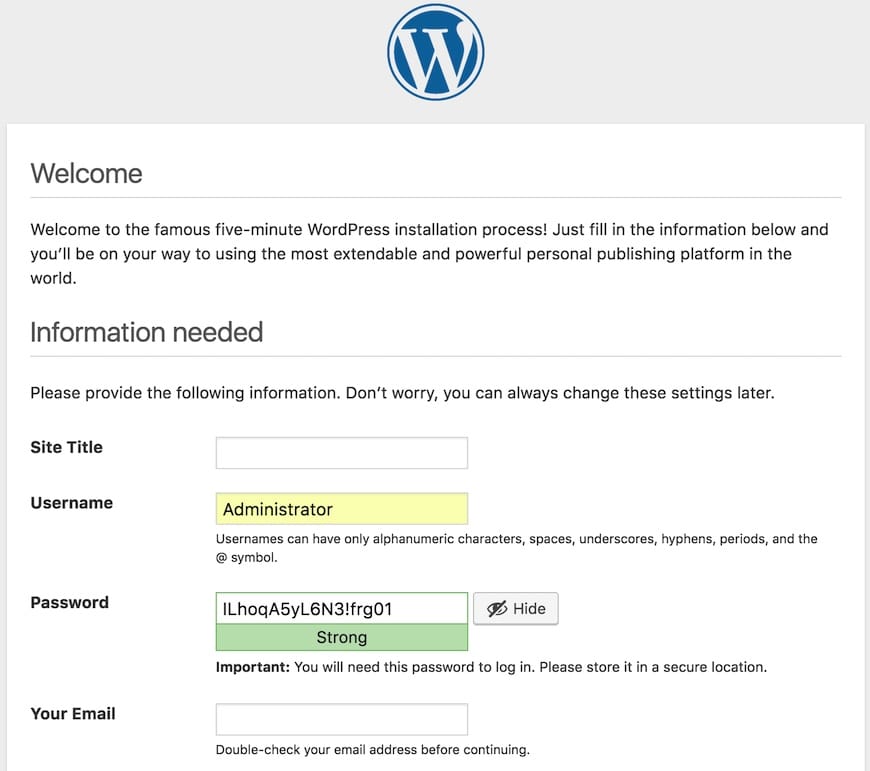How To Install WordPress on Linux Mint 22

WordPress stands as a titan in the realm of Content Management Systems (CMS), celebrated for its adaptability and user-friendly interface. Powering millions of websites, from personal blogs to sprawling e-commerce platforms, its open-source nature and extensive plugin ecosystem make it a favorite among developers and content creators alike. Linux Mint 22, known for its stability and ease of use, provides an excellent environment for hosting WordPress. This tutorial provides a detailed, step-by-step guide on how to install WordPress on Linux Mint 22, ensuring a smooth and efficient setup. You’ll quickly discover how straightforward this process is, and soon, you’ll be ready to build your dream website!
Prerequisites
Before diving into the installation process, it’s essential to ensure your system meets the necessary prerequisites. This will help prevent potential issues and ensure a seamless setup of your WordPress site.
- A Running Instance of Linux Mint 22: This guide assumes you have a working installation of Linux Mint 22. If not, you’ll need to install it before proceeding.
- Basic Knowledge of Linux Command-Line: Familiarity with basic Linux commands is essential for executing installation steps. Don’t worry; the commands are straightforward and easy to follow.
- An Active Internet Connection: An internet connection is required to download necessary packages and WordPress files. Ensure your connection is stable throughout the installation.
- A User Account with Sudo Privileges: You’ll need a user account with sudo privileges to install software and modify system settings. This is crucial for performing administrative tasks.
Each of these prerequisites plays a vital role in the successful installation of WordPress. Skipping these steps may lead to errors or compatibility issues.
Step 1: Update the System
Updating your system is a crucial first step. An updated system ensures you have the latest security patches and software versions, reducing the likelihood of conflicts during the WordPress installation. This is a fundamental step in maintaining system stability.
Open your terminal and execute the following commands:
sudo apt update
sudo apt upgradeThe sudo apt update command refreshes the package list, while sudo apt upgrade upgrades the installed packages to their latest versions. This process might take a few minutes, depending on your internet connection and system configuration. These commands are essential for ensuring your system is running smoothly before installing new softwar.
Step 2: Install Apache Web Server
Apache is a widely-used web server that will host your WordPress site. It’s responsible for serving your website files to visitors. Installing Apache is straightforward and essential for running WordPress.
Use the following command to install Apache:
sudo apt install apache2Once the installation is complete, start the Apache service with:
sudo systemctl start apache2To ensure Apache starts automatically on boot, enable it with:
sudo systemctl enable apache2Verify the installation by opening a web browser and navigating to http://localhost/. You should see the default Apache welcome page, confirming that Apache is running correctly. If you encounter any issues, double-check the commands and ensure your system is connected to the internet. This verification step ensures that the web server is properly installed and accessible.
Step 3: Install MySQL/MariaDB Database Server
WordPress requires a database to store its data, including posts, pages, and settings. MySQL and MariaDB are popular database management systems that work well with WordPress. This guide uses MariaDB due to its open-source nature and compatibility.
Install MariaDB with the following command:
sudo apt install mariadb-server mariadb-clientAfter installation, start the MariaDB service:
sudo systemctl start mariadbEnable MariaDB to start on boot:
sudo systemctl enable mariadbSecure your MariaDB installation by running:
sudo mysql_secure_installationThis command will guide you through setting up a root password and other security options. It’s crucial to set a strong root password and answer the security questions carefully to protect your database. Securing your database is a critical step in protecting your WordPress site.
Step 4: Install PHP and Required Extensions
WordPress is written in PHP, so you’ll need to install PHP along with several extensions for WordPress to function correctly. These extensions provide additional functionalities and ensure compatibility.
Install PHP and the necessary extensions with:
sudo apt install php libapache2-mod-php php-mysql php-gd php-curl php-mbstring php-xml php-imagickOnce installed, restart the Apache service to enable the new PHP modules:
sudo systemctl restart apache2Verify the PHP installation by creating a phpinfo file in the web server’s document root. Create a file named info.php:
sudo nano /var/www/html/info.phpAdd the following content:
<?php
phpinfo();
?>Save the file and access it via your web browser by navigating to http://localhost/info.php. You should see a page displaying your PHP configuration information. Remember to delete this file after verification, as it can pose a security risk if left exposed. This ensures that PHP is correctly installed and configured for WordPress.
Step 5: Download and Extract WordPress
Now, download the latest version of WordPress from the official website and extract it to the web server’s document root. This involves navigating to the temporary directory, downloading the WordPress archive, and extracting its contents.
Navigate to the /tmp directory:
cd /tmpDownload the latest WordPress package using wget:
sudo wget https://wordpress.org/latest.tar.gzExtract the downloaded archive:
sudo tar -xvzf latest.tar.gzMove the WordPress files to the web server document root:
sudo mv wordpress/* /var/www/html/This ensures that all WordPress files are correctly placed in the directory that Apache serves.
Step 6: Configure WordPress Directory Permissions
Setting the correct file permissions is crucial for WordPress to function securely. Incorrect permissions can lead to security vulnerabilities or prevent WordPress from writing to necessary files.
Set the ownership of the WordPress files to the Apache user (www-data):
sudo chown -R www-data:www-data /var/www/html/Set appropriate permissions:
sudo chmod -R 755 /var/www/html/These commands ensure that Apache has the necessary permissions to read and write files within the WordPress directory.
Step 7: Create a MySQL/MariaDB Database and User for WordPress
WordPress needs a database to store its data. Create a database and a user account with the necessary privileges to access and modify the database. This ensures that WordPress can properly manage its data.
Log in to the MariaDB shell as the root user:
sudo mysql -u root -pEnter the root password you set during the MariaDB installation. Then, execute the following SQL commands:
CREATE DATABASE wordpress;
CREATE USER 'wordpressuser'@'localhost' IDENTIFIED BY 'password';
GRANT ALL PRIVILEGES ON wordpress.* TO 'wordpressuser'@'localhost';
FLUSH PRIVILEGES;
exitReplace 'password' with a strong, unique password. These commands create a database named wordpress, a user named wordpressuser, and grant the user full access to the database.
Step 8: Configure WordPress wp-config.php File
The wp-config.php file contains essential configuration settings for WordPress, including database connection details. Configuring this file correctly is crucial for WordPress to connect to the database.
Navigate to the WordPress directory:
cd /var/www/html/Copy the sample configuration file:
sudo cp wp-config-sample.php wp-config.phpOpen the wp-config.php file in a text editor:
sudo nano wp-config.phpModify the following lines with your database details:
define( 'DB_NAME', 'wordpress' );
define( 'DB_USER', 'wordpressuser' );
define( 'DB_PASSWORD', 'password' );
define( 'DB_HOST', 'localhost' );Replace 'wordpress', 'wordpressuser', and 'password' with the database name, username, and password you created in the previous step. Also, update the security keys and salts. You can generate unique keys from the WordPress API:
define('AUTH_KEY', 'put your unique phrase here');
define('SECURE_AUTH_KEY', 'put your unique phrase here');
define('LOGGED_IN_KEY', 'put your unique phrase here');
define('NONCE_KEY', 'put your unique phrase here');
define('AUTH_SALT', 'put your unique phrase here');
define('SECURE_AUTH_SALT', 'put your unique phrase here');
define('LOGGED_IN_SALT', 'put your unique phrase here');
define('NONCE_SALT', 'put your unique phrase here');Save the file. This configuration ensures that WordPress can connect to the database and retrieve necessary information.
Step 9: Configure Apache Virtual Host for WordPress
Creating an Apache virtual host allows you to host multiple websites on a single server. This step involves creating a new configuration file for your WordPress site and enabling it.
Create a new Apache configuration file for WordPress:
sudo nano /etc/apache2/sites-available/wordpress.confAdd the virtual host configuration:
<VirtualHost *:80>
ServerAdmin admin@example.com
DocumentRoot /var/www/html/
ServerName example.com
ServerAlias www.example.com
<Directory /var/www/html/>
AllowOverride All
Require all granted
</Directory>
ErrorLog ${APACHE_LOG_DIR}/error.log
CustomLog ${APACHE_LOG_DIR}/access.log combined
</VirtualHost>Replace example.com with your domain name. Save the file and enable the new virtual host:
sudo a2ensite wordpress.confDisable the default Apache site:
sudo a2dissite 000-default.confTest the Apache configuration:
sudo apachectl configtestRestart the Apache service:
sudo systemctl restart apache2This configuration ensures that your WordPress site is correctly configured within Apache.
Step 10: Access the WordPress Installation Wizard
Now that you’ve configured the server and files, you can access the WordPress installation wizard through your web browser. This final step involves setting up your site title, admin credentials, and email address.
Open a web browser and navigate to your server’s IP address or domain name. Follow the on-screen instructions to complete the WordPress installation:
- Choose a Site Title: Enter the name of your website.
- Set Up Administrator Username, Password, and Email Address: Create a strong username and password for the administrator account. Provide a valid email address for password recovery and notifications.
Once completed, you can log in to your WordPress dashboard and begin customizing your site.

Step 11: Post-Installation Steps
After installing WordPress, there are several post-installation steps to optimize your site and enhance its functionality.
- Log in to the WordPress Dashboard: Access the dashboard by navigating to
yourdomain.com/wp-admin. - Choose a Theme: Select a theme that suits your website’s purpose and design preferences.
- Install Necessary Plugins: Install plugins for added functionality, such as SEO, security, and contact forms.
- Configure Permalinks: Set up SEO-friendly permalinks by navigating to Settings > Permalinks.
- Set Up a Static Front Page: Create a static front page for your website by navigating to Settings > Reading.
These steps will help you create a functional and well-optimized WordPress site.
Troubleshooting Common Issues
During the installation process, you may encounter some common issues. Here are a few troubleshooting tips to help you resolve them:
- Error Establishing a Database Connection
- Verify database credentials in
wp-config.php. - Ensure the MySQL/MariaDB server is running.
- Verify database credentials in
- Internal Server Error
- Check the
.htaccessfile for errors. - Verify file permissions.
- Check the
- Website is Not Accessible
- Check Apache virtual host configuration.
- Ensure the Apache server is running.
- Check for firewall issues blocking access.
These troubleshooting steps can help you quickly identify and resolve common issues.
Securing WordPress
Securing your WordPress site is crucial to protect it from potential threats. Here are some essential security measures:
- Keep WordPress, Themes, and Plugins Updated: Regularly update your WordPress installation, themes, and plugins to patch security vulnerabilities.
- Use Strong Passwords: Use strong, unique passwords for all user accounts.
- Install Security Plugins: Install security plugins like Wordfence or Sucuri to add extra layers of protection.
- Enable Two-Factor Authentication: Enable two-factor authentication for administrator accounts.
- Limit Login Attempts: Use plugins to limit the number of failed login attempts to prevent brute-force attacks.
Implementing these security measures will significantly enhance your WordPress site’s security.
Optimizing WordPress Performance
Optimizing your WordPress site’s performance is essential for providing a fast and seamless user experience. Here are some tips to improve your site’s performance:
- Use a Caching Plugin: Install a caching plugin like WP Super Cache or W3 Total Cache to improve page load times.
- Optimize Images: Optimize images to reduce file sizes without sacrificing quality.
- Use a Content Delivery Network (CDN): Use a CDN to distribute your website’s content across multiple servers, reducing latency.
- Choose a Fast Hosting Provider: Select a hosting provider that offers fast and reliable servers.
These optimization techniques will help improve your WordPress site’s performance and user experience.
Congratulations! You have successfully installed WordPress. Thanks for using this tutorial for installing the latest version of WordPress on the Linux Mint 22 system. For additional help or useful information, we recommend you check the official WordPress website.